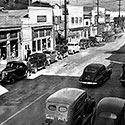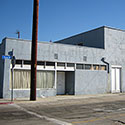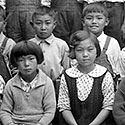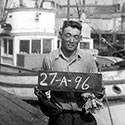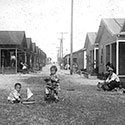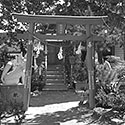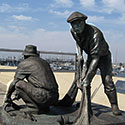 |
Terminal IslandTerminal Island, also referred to as East San Pedro Fish Harbor, is remembered with nostalgia as a distinct Japanese fishing village with its own culture and lifestyle. Upon viewing the bay, an early group of Southern Pacific Railroad laborers yearned to utilize their skills from Japan and began an abalone cooperative at White Point in the San Pedro Bay in the 1890s. Although abalone diving was promising, lack of demand for abalone in the U.S. curtailed its success. Soon after, Japanese fishermen built small rowboats to explore the San Pedro Bay for tuna and used 6-foot poles for their catch. By 1907, the Japanese fishing village of Fish Harbor was established with its first houses built on pilings along the shore of the main channel. Within a few years, the Japanese population on Terminal Island had increased to 600. The tight-knit community, living in isolation, developed their own blend of Japanese and English, referred to as “kii-shu ben”, a dialect from the Kii district in Wakayama, the township where many had immigrated. While small motorboats increased the distance traveled for their catch, Japanese immigrants devised an unprecedented fishing technique. They would send an advance boat to scout for schools of albacore tuna, and catch the anchovies and sardines the tuna followed for live bait. Then, a fishing vessel with a team of fishermen would release the bait and spear the tuna using short bamboo poles with hooks while standing on the steel walkways near the hulls and toss them on to the deck of the boat. Due to local fishermen’s high yield of tuna, a number of fish canneries began to open on Terminal Island. By the 1930s, the Japanese community had increased to 2,000 with most of the men employed as fishermen and the women working in the canneries. At its height in 1942, the Nikkei population had grown to 3,000, just prior to its abrupt demise following the bombing of Pearl Harbor. ›› CLICK TO ENLARGE.
PROFILES
| ||||

On Tuna Street, the main business center was established with markets, dry goods stores, barbershops, and pool halls, while the school, churches, and community activities were primarily located on Terminal Way. Fishermen Hall was built for community and cultural activities in 1916 and in the same year, a Baptist Mission was established on the eastern edge of the island. Across the alley from the church, a baseball field hosted the “San Pedro Skippers”, an often-undefeated local team. This ca. 1930 photo of Tuna Street shows businesses such as Hashimoto Co. and Hama Hardware that provided hardware items and fishing nets, poles, and hooks for the commercial fishermen. Also in view are the Marin Café, and Ben’s Sweet Shop, which offered sweet azuki bean snowcones. Photo courtesy of Bancroft Library circa 1930.
The contributions of Japanese immigrants to the fishing industry was noted by Dr. N.B. Scofield of the California State Fish and Game Commision in 1926, "The Japanese are very efficient fishermen; they are ingenious and resourceful, and work very hard. . . the Japanese are the only ones who are able to deliver the quantity for albacore required by the canneries." Yet, Japanese fishermen, along with the community leaders, were the first to be searched by the FBI after the bombing of Pearl Harbor. Terminal Islanders, under scrutiny because of their port location and rising racial hysteria, became suspect for owning boats and for short wave radios they used to communicate to the canneries. All Japanese owning commercial boats were immediately questioned and forbidden to leave the harbor, then were arrested two days later. Within 48 hours, 1,291 Issei had been arrested and detained.
At first, the remaining residents were given a 30-day eviction notice, but ten days later a submarine scare led to the mass eviction from the island upon only a 48-hour notice. After the war, animosity toward the Nikkei fishermen continued and through an amendment to a 1933 statute of the California Fish and Game Code, Issei were denied a commercial license. The statute was challenged by Takahashi vs. Fish and Game Commission in the Los Angeles City, California State and U.S. Supreme Court until it was overturned several years later. Photo of local fisherman taken by the FBI, 1941.

Located at the corner of Tuna and Cannery Streets, Nanka Shokai, or Southern California Store, was a clothing store. While factory housing, the community hall, churches, and a school were among the buildings razed during World War II, this portion of Tuna Street remains intact. The Terminal Island Monument, located across the harbor, tells the unique story of the East San Pedro Japanese community. A life-size bronze fisherman draws in the commercial fishing net, while another fisherman stooping low peers across toward the silhouette of Fish Harbor.

The 1918 California State Fishing Bill prohibited Japanese “aliens” from owning their own boats, causing many to skipper boats owned by the canneries. The cannery offered only 49% to the fishermen and provided modest apartments units in company-owned rental housing. The cannery worker homes were long, wooden barrack buildings with quarters that varied by size depending on their job. There would be as many as four families living in one building, or one family in a two-room space. The homes were identical from the exterior, yet the interior gave hints of those with higher earnings such as a part-owner of a boat, who may have a new refrigerator instead of the traditional icebox, a Victrola to play music, or a piano in their front room. Only the main streets of the Terminal Island community were paved and the alleys between the houses filled with sand. Many tenants built wooden walkways between structures, and an ofuro (bath house) on the back porch of their homes.
With their livelihood dependent on the fresh catch, a 24-hour whistle often called the women to the factory in the middle of the night, leaving their children home alone tucked in bed. Neighbors who were not working would keep an eye out for the children. But most often, with their fathers at sea and mothers at the factory, children would fend for themselves and their younger siblings. Many Terminal Islanders have fond memories of growing up on the protected island, playing kick the can and other outdoor games on the sand lots in the evenings, swimming or roasting wieners on a beach campfire in the summer. Photo from Furusato – The Lost Village of Terminal Island.

Where Tuna Street meets the Fish Harbor wharf, the historic site of Tokiwa Low and Hidaka Shinyukai remains. The restaurant signage with Japanese characters is still visible from the sidewalk, but the storefront has been enclosed with metal bars. Two plaques hanging in the stairwells recognize the World Martial Arts Association, and the Bell of Friendship Restoration Association at the current site.
There were several restaurants along Tuna Street prior to WWII. Tokiwa Low served Japanese food and must have been a welcome sight to returning fishermen. Located across the street, Mio’s Cafe was frequented by the non-Japanese cannery employees and wharf workers. Showa Low, a Chinese restaurant located on the second floor, could accommodate groups and often hosted special events, such as wedding banquets or anniversary parties.

Emblazed in the memory of Terminal Islanders is the tall torii gate that stood at the entrance of the Shinto Shrine, a structure rare to find outside of Japan. In addition to the continuance of Shinto and Buddhist practices, Christian traditions in the U.S. also became part of the Terminal Island community. The small island had a Baptist Church, a Shinto shrine, a Buddhist temple, and a Tenrikyo church. Behind the Shinto shrine was the judo dojo, a long wooden building filled with white mats. Fishermen’s Hall provided space for the kendo dojo and showing of Japanese films; and the community celebrated both Boy’s Day and Girl’s Day. Photo from Furusato – The Lost Village of Terminal Island.

A flagpole was the first fixture installed on the East San Pedro School site by the Los Angeles School District, and the American flag became a symbolic marker of the role that the school played in introducing American culture and the English language to the immigrant children of Terminal Island. The LA City School records show the school opening in the fall of 1918. However, some students recall meeting in a private home prior to this date. Miss Mildred Obarr (later to become Mrs. Walizer and to serve as principal from 1921–32) and Miss Annie Garcia were the first assigned to teach at the school.
The Fukei Kai was established to rally community support for the school and collected a membership due from all residents to offset expenses. The group helped to built a pond and bridge in 1924, accentuating a uniquely Japanese aesthetic to the public school site. They also purchased playground equipment, built tennis courts, and established a library for the school and community. By 1931, the school campus included eleven bungalows for approximately 450 students. The photo was taken in the second year, 1919. Photo from the Annie Garcia collection, San Pedro Bay Historical Society.

The strong bond between Terminal Islanders never wavered in spite of the loss of the island village, razed by the Navy during World War II, and the waning of the independent commercial fishing industry. Without a home to return to, the Terminal Islanders determined to re-gather, formed a club in 1971, and began to host an annual picnic and New Year’s party. With concern for its legacy, Terminal Islanders lead a successful campaign and dedicated the Terminal Island Monument in 2002. Upon the bridge of the monument, historic photos of the Fish Harbor community narrate the story, while the towering torii gate announces its proud Japanese heritage. The Terminal Island Monument accentuated by the torii gate is reminiscent of the Shinto shrine and the arching bridge reflects the Japanese garden at East San Pedro grammar school. The bronze statue of two Nisei fishermen pulling in their nets emblazons the contribution of the East San Pedro Fish Harbor to the industry in California.
